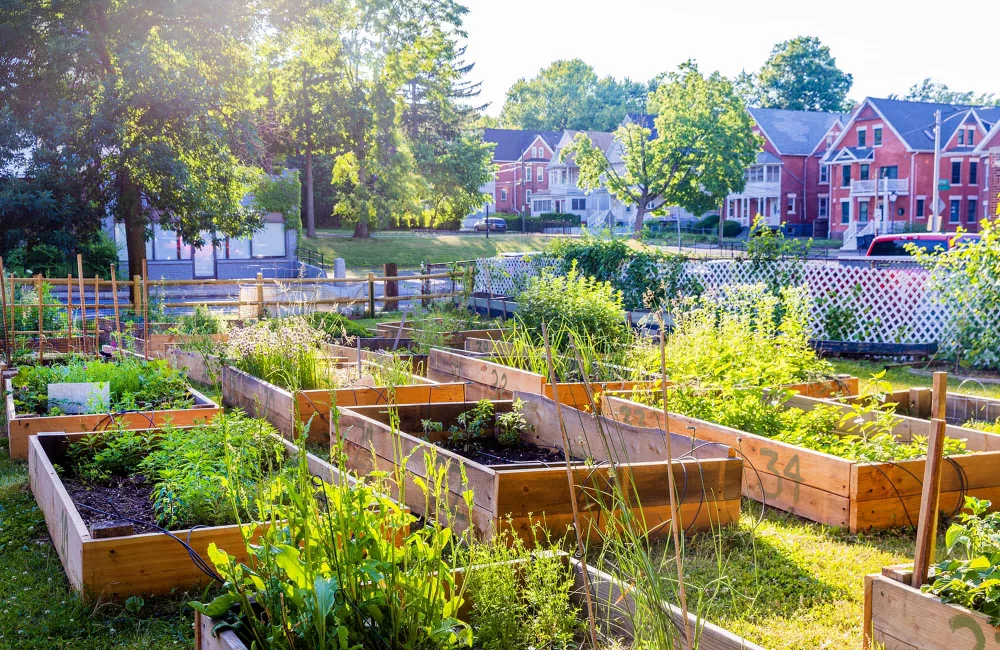Community gardens have surged in popularity as more people recognize the rewards of working the soil together. These shared spaces transform underutilized plots into vibrant hubs of fresh produce, environmental stewardship, and neighborhood unity. Whether you have a green thumb or you’re taking your very first steps into the world of horticulture, becoming involved in a community garden can be a deeply fulfilling experience. Beyond simply growing vegetables, it’s about nurturing relationships, promoting sustainability, and building a sense of belonging.
In what follows, we will explore 18 compelling benefits of participating in community gardens. From fostering social connections to providing educational opportunities, these benefits touch on various aspects of emotional, physical, and communal well-being. If you’re curious about how gardening with neighbors can positively impact your life and your local environment, read on and discover why these shared plots of land have become shining examples of collective effort and progress.
1. Fosters Social Connections
Community gardens naturally bring people together, giving neighbors a chance to interact and collaborate in a welcoming outdoor setting. When you spend time planting seeds or watering rows of crops, you share a common goal that sparks conversations, breaks down barriers, and encourages mutual support. Over time, these casual exchanges can develop into deeper friendships, especially when you celebrate harvests or plan garden improvements as a team.
Stronger social connections not only boost morale but also foster a heightened sense of trust and safety among community members. You may find yourself learning from others who have different backgrounds and gardening techniques, thus broadening your horizons. These ongoing interactions unify the neighborhood, leading to more inclusive events, supportive relationships, and a genuinely cohesive community spirit.
2. Encourages Physical Activity
Regular gardening tasks—like digging, weeding, lifting, and watering—provide an excellent workout that exercises multiple muscle groups. Unlike going to the gym, gardening offers a low-impact form of exercise that is easier on the joints but still capable of improving strength, flexibility, and endurance. Whether you’re turning the soil to prepare new planting beds or hauling compost to nourish the plants, these repetitive movements add up to a heart-healthy routine.
This kind of outdoor physical activity is also a great way to fight a sedentary lifestyle. Instead of spending free time on the couch or in front of a screen, you can burn calories and stay active while engaging in purposeful tasks. By replacing inactivity with gardening, you can enhance your overall fitness level, maintaining better weight control and improving cardiovascular health.
3. Provides Access to Fresh, Nutritious Produce
One of the most direct benefits of community gardening is the consistent availability of fresh, locally grown produce. When you grow your own vegetables, herbs, or fruits, you have control over the cultivation process, ensuring that harmful chemicals or pesticides aren’t part of the equation. This results in nutrient-dense, organic produce that tastes superior to many store-bought options.
Moreover, the affordability of garden-grown produce can reduce the economic burden of purchasing expensive groceries. You can harvest fresh lettuce for salads, tomatoes for sauces, or peppers to spice up a dish without worrying about cost. This benefit is particularly meaningful in communities that lack convenient access to healthy food, transforming the garden into a valuable resource for battling food insecurity.
4. Promotes Sustainability and Environmental Awareness
Working closely with the land fosters a deeper appreciation for eco-friendly practices. Gardeners quickly learn about the importance of composting, soil health, water conservation, and responsible pest management. This hands-on experience makes environmental stewardship feel tangible and achievable, motivating gardeners to apply sustainable methods in other areas of their lives.
As you grow plants alongside fellow community members, you’ll likely pick up tips on crop rotation, mulching, or natural fertilizers. These techniques help maintain soil fertility while minimizing harmful impacts on local ecosystems. By implementing these lessons, gardeners not only improve the immediate vicinity but also become advocates for broader environmental consciousness, ultimately influencing friends, neighbors, and future generations.
5. Enhances Mental Health and Well-Being
Studies repeatedly show that spending time in nature can alleviate stress, reduce anxiety, and boost overall mood. Community gardens offer the perfect setting for these therapeutic effects, merging the calming influence of greenery with the empowering experience of nurturing living things. Tending to seeds, watching them grow into mature plants, and finally harvesting the fruits of your labor is deeply satisfying.
In addition to the natural setting, the communal aspect of gardening helps combat feelings of isolation. When working beside others, you gain a sense of purpose and belonging that can uplift your spirits. This improved emotional state often translates to better sleep, reduced tension, and heightened resilience in the face of life’s daily challenges.
6. Builds a Sense of Community Ownership
When local residents come together to create and maintain a green space, they develop a shared sense of ownership and responsibility for that area. This collective pride encourages everyone to safeguard the garden from littering, vandalism, or neglect. People are more likely to respect and protect a space that they’ve helped nurture, thus creating a positive feedback loop of continuous care and improvement.
This investment of time and effort also strengthens neighborhood bonds. Because everyone contributes in some way—be it planting seeds, coordinating events, or providing tools—each individual becomes a stakeholder in the garden’s success. The result is a more unified community that values collaboration, open communication, and joint efforts to shape the future of their shared environment.
7. Encourages Cultural Exchange
Community gardens often attract individuals from diverse ethnicities, cultures, and age groups, resulting in a shared environment brimming with varied perspectives. Gardeners may bring seeds from their home countries or use cultivation methods passed down through generations. This mixture of plant varieties and techniques enriches the overall experience, inspiring everyone to learn something new.
Beyond the plants themselves, interactions between gardeners promote understanding and appreciation of different cultural backgrounds. You might learn new recipes, discover unfamiliar cooking methods, or gain insights into holiday traditions that incorporate particular crops. Over time, these exchanges expand your worldview and teach you how gardens can serve as bridges for connection and unity.
8. Offers Educational Opportunities
For both children and adults, community gardens serve as living classrooms that demonstrate the principles of botany, ecology, and nutrition in a hands-on way. Kids can learn the basics of plant anatomy, photosynthesis, and the importance of pollinators simply by observing the daily activities in a bustling garden. Similarly, adults might refine their knowledge of gardening techniques, composting, or landscape design.
Workshops, classes, and informal mentoring are often part of community gardening initiatives, enabling participants to broaden their skill set. Whether it’s mastering seed starting or learning how to recognize beneficial insects, these lessons become invaluable resources that can be applied at home or shared with neighbors. This ongoing education nurtures curiosity and fosters personal growth, proving that gardens aren’t just for growing plants—they’re also for cultivating minds.
9. Reduces Urban Heat Island Effect
Community gardens, with their lush greenery and shaded areas, help mitigate the urban heat island effect, where densely built regions trap more heat than surrounding rural locations. Plants naturally cool the air through a process known as evapotranspiration, and garden plots often include trees or trellises that provide additional cover. By introducing green spaces into concrete-dominated neighborhoods, these gardens create comfortable microclimates that moderate extreme temperatures.
This cooling effect can also lead to energy savings for nearby homes, as less reliance on air conditioning may be needed. Over time, widespread integration of community gardens throughout a city can contribute to improved air quality and overall environmental health. In essence, each community garden is a small yet meaningful step toward making urban environments more hospitable and eco-friendly.
10. Strengthens Local Food Security
By producing fresh fruits and vegetables close to where people live, community gardens play a crucial role in enhancing local food security. Relying on distant supply chains can make neighborhoods vulnerable to shortages, especially during crises or natural disasters. Yet, when residents cultivate a portion of their own food, they reduce dependence on external sources, fostering greater resilience in the face of disruptions.
Moreover, gardens can be designed to yield a surplus of produce, which participants might choose to donate to local shelters, food banks, or community centers. These charitable contributions help ensure that fresh, nutritious foods reach the tables of those who might otherwise struggle to afford them. Thus, community gardens function as a safety net, bridging gaps in the local food system.
11. Creates Opportunities for Intergenerational Engagement
Community gardens draw people of all ages, from young children eager to learn about nature to retirees looking for a fulfilling pastime. This wide age spectrum fosters intergenerational learning, where older participants can share time-tested gardening wisdom, and younger participants can introduce modern ideas or new technologies. Working side-by-side, they learn from each other’s unique perspectives, bridging generational divides.
This intermingling also helps reduce age-related isolation, particularly for seniors who might otherwise spend much of their time alone. Younger gardeners benefit from role models who have decades of life experience and can impart practical skills. Ultimately, these shared endeavors create a welcoming space where everyone, regardless of age, feels valuable and connected.
12. Boosts Local Economy
Although community gardens are typically not profit-driven, they can stimulate the local economy in multiple ways. First, thriving gardens often become points of interest, attracting visitors to the neighborhood. These visitors might frequent nearby shops, cafes, or farmers’ markets, infusing revenue into local businesses. Additionally, some gardens establish partnerships with local restaurants or grocery stores to sell surplus produce, creating a modest economic boost.
Moreover, gardeners regularly purchase supplies like tools, gloves, compost, and seeds, supporting local hardware stores and garden centers. If the garden hosts educational workshops or events, it may also bring in speakers or vendors, again contributing to the local economy. Over time, the improved aesthetics and reputation of a well-maintained garden can even raise property values in the surrounding area, further benefiting the community.
13. Provides a Safe Outdoor Gathering Space
In many neighborhoods, public areas for safe and meaningful gatherings are limited. Community gardens fill this void by offering a family-friendly location where people can socialize, hold celebrations, or simply enjoy an afternoon. Events like harvest festivals, seed swaps, and community potlucks become highlights that bring residents together for positive and constructive engagement.
Because the garden is maintained by local participants, there’s a shared sense of accountability in keeping it clean, organized, and welcoming. Children can play or learn about plants under the watchful eyes of parents and neighbors, while adults can unwind in a peaceful environment free from heavy traffic or urban noise. This communal safe haven enriches the social fabric, ensuring that everyone feels comfortable and at home within the neighborhood.
14. Encourages Sharing and Collaboration
From sharing gardening tools and resources to swapping seeds and recipes, a community garden embodies a spirit of collaboration. Gardeners often coordinate schedules for watering or weeding, ensuring that tasks are accomplished efficiently and that no individual is overburdened. This culture of teamwork extends into other aspects of community life, making it simpler to plan neighborhood events or address common challenges.
Group decision-making is also integral to managing a community garden’s layout, seasonal crops, or expansions. Through open forums and discussion, participants learn to compromise, respect diverse opinions, and celebrate collective wins. These experiences can be applied beyond the garden as well, empowering neighbors to come together for broader local initiatives and improvements.
15. Offers Therapeutic Benefits for Vulnerable Populations
Community gardening can be particularly beneficial for individuals dealing with mental health challenges, physical disabilities, or social isolation. Engaging with nature through sensory experiences—touching soil, smelling blooming flowers, or listening to rustling leaves—offers a grounding effect. This soothing environment can help reduce symptoms of depression, anxiety, or chronic stress, allowing participants to heal in a non-judgmental space.
Gardens can also be adapted for individuals with limited mobility by incorporating raised beds or accessible pathways. The ability to successfully grow and care for plants can enhance self-esteem and foster independence. For those who have experienced trauma, nurturing something living often serves as a gentle form of therapy, providing a renewed sense of purpose and optimism.
16. Improves Neighborhood Aesthetics
An overgrown, vacant lot can turn into a picturesque oasis with careful planning and consistent effort. Community gardens transform blighted spaces into green landscapes filled with vibrant plants, flowers, and pollinator-friendly habitats. This visual transformation can boost morale and foster a greater sense of community pride, helping people feel good about the place where they live.
In many cases, a well-maintained community garden can also deter criminal activity or illegal dumping by eliminating neglected, poorly lit areas. When residents take control of their environment, it sends a clear message that they are invested in maintaining a safe, welcoming neighborhood. A cleaner, greener setting attracts positive attention, inspiring other beautification projects that can lead to an ongoing revitalization of the entire area.
17. Deepens Connection to Nature
In an age where technology and screens often dominate our lives, community gardens provide a refreshing opportunity to reconnect with the natural world. Observing the life cycle of plants—from seedling to harvest—allows you to witness nature’s resilience and adaptability firsthand. This tangible experience encourages mindfulness, reminding you of the delicate interdependence between people, plants, and wildlife.
When you learn to appreciate seasonal changes and the importance of biodiversity, your perspective on daily life can shift. Activities like composting reinforce the idea that organic waste is not merely trash but a vital resource that enriches the soil. This heightened awareness permeates other lifestyle choices, potentially motivating you to reduce plastic usage, recycle more diligently, or support conservation efforts in your region.
18. Inspires Civic Engagement
Joining a community garden frequently leads to greater civic involvement because participants develop a vested interest in local issues. Once you see firsthand how transformative collective action can be, you may feel inspired to attend town hall meetings, volunteer for other community projects, or vote in local elections. The garden serves as proof that citizens have the power to shape their surroundings in positive ways.
Additionally, gardens often collaborate with schools, senior centers, and non-profit organizations to spearhead educational or charitable programs. These initiatives can broaden your network and introduce you to local leaders, decision-makers, and activists. When you grasp the influence of community-led projects, it becomes easier to imagine larger-scale changes that address everything from urban sustainability to social inequality, fueling a deeper commitment to civic life.
Conclusion
Community gardens are about far more than just planting seeds; they represent a collective effort to enrich neighborhoods, protect the environment, and foster togetherness. Whether you are passionate about organic produce, education, social inclusion, or simply enjoy the serenity of nature, these shared spaces offer opportunities to grow on many levels. Each raised bed, each sprouting seedling, and each harvested tomato symbolizes collective passion, hard work, and a desire for positive change.
By participating in community gardening, you embrace a culture of sharing, learning, and caring that extends well beyond the garden fence. You strengthen the local fabric through deeper social connections, enhanced well-being, and a dedication to nurturing the land you share with others. Ultimately, this journey is a testament to how small acts—like watering a plant or composting kitchen scraps—can culminate in significant transformations, both for your community and for your own personal growth.






